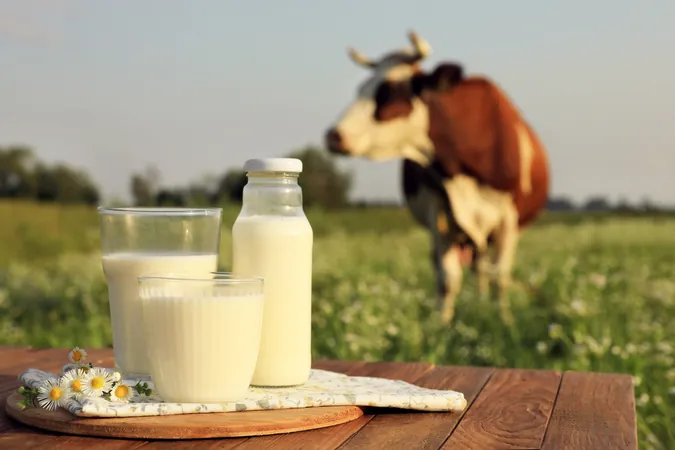
Avian Flu Contamination Detected in Raw Milk: Why Pasteurization is Essential for Your Safety!
2024-12-08
Author: Sophie
Introduction
As the H5N1 avian flu virus continues its troubling spread among poultry and livestock, many consumers are justifiably concerned about the safety of milk in the United States. Thankfully, the U.S. Food and Drug Administration (FDA) assures that pasteurized milk is safe for consumption. However, recent events have raised significant alarms about the risks associated with raw (unpasteurized) milk.
Recent Developments
In late November, California officials took precautionary measures by recalling two batches of raw milk from a Fresno dairy farm following the detection of avian flu virus remnants. While no human cases have been reported in connection to these products yet, health authorities urged consumers to avoid drinking the recalled milk and return it to their point of purchase. Additionally, the affected farm faced restrictions that prevented the distribution of further raw dairy products.
The Risks of Raw Milk
Despite rising sales of raw milk in the U.S., health experts continue to warn consumers about the potential dangers it poses. Some public figures advocate for raw milk, arguing that it offers health benefits, contrasting with the stance of the FDA and food scientists promoting pasteurization as a necessary safety measure.
Raw milk can harbor various pathogens that pose serious health risks. Dairy cows are often exposed to outdoor elements, staying in barns that may harbor contaminants like mud and manure. The collection and transportation of milk create further opportunities for bacterial contamination.
Common Pathogens in Raw Milk
Pathogens commonly associated with raw milk include: - **Listeria monocytogenes:** This bacterium can cause listeriosis, leading to serious complications such as miscarriages in pregnant women. - **E. coli:** Known for causing severe gastrointestinal issues, certain strains can lead to life-threatening conditions like kidney failure. - **Campylobacter:** A leading cause of foodborne illness in the U.S., it typically results in diarrhea and abdominal pain. - **Salmonella:** This pathogen is another culprit behind several foodborne illness outbreaks, causing symptoms such as diarrhea and fever.
The Importance of Pasteurization
The process of pasteurization, invented by French scientist Louis Pasteur in the 1860s, revolutionized food safety. Initially used to preserve wine and beer, it has since become vital for dairy products. In fact, prior to World War II, milk accounted for a staggering 25% of foodborne illness outbreaks in the U.S., prompting the need for strict pasteurization laws. By 1973, U.S. regulations mandated that all milk sold between states must be pasteurized, with additional measures implemented to ban the interstate sale of raw milk in 1987.
Pasteurization involves heating raw milk to a specific temperature for a predetermined amount of time to eliminate pathogens. This process is scientifically tailored to ensure that the milk is safe and has an extended shelf life.
Methods of Pasteurization
Several methods exist for pasteurization, including: - **Vat Pasteurization:** Used mainly by smaller dairy producers, where milk is heated to 145°F (63°C) for 30 minutes. - **High-Temperature Short-Time Pasteurization:** A more common method that heats milk to 161°F (71°C) for just 15 seconds, allowing for large-scale production. - **Ultra-High Temperature Pasteurization:** This method quickly heats milk above 285°F (140°C), giving products an extended shelf life of up to a year when properly packaged.
The Avian Flu Concern
The detection of avian flu virus fragments in raw milk has heightened concerns in the dairy industry. Although preliminary research indicates that pasteurization effectively inactivates the virus, the FDA urges consumers to refrain from drinking raw milk due to potential health risks associated with pathogens.
As of early December 2024, there have been confirmed cases of H5N1 in humans within the U.S., primarily among those in contact with infected animals. Recent cases involved young individuals, highlighting that children may be more vulnerable to the virus than adults.
Conclusion
Medical experts emphasize the need for continued research into the transmission of avian flu, reaffirming that the risks associated with raw milk consumption are simply not worth taking. When it comes to milk, choose pasteurization for your health and safety! In a world where food safety is crucial, understanding the benefits of pasteurization and the risks associated with raw dairy products can be life-saving. Don't take unnecessary risks—opt for pasteurized milk and protect your health today!



 Brasil (PT)
Brasil (PT)
 Canada (EN)
Canada (EN)
 Chile (ES)
Chile (ES)
 Česko (CS)
Česko (CS)
 대한민국 (KO)
대한민국 (KO)
 España (ES)
España (ES)
 France (FR)
France (FR)
 Hong Kong (EN)
Hong Kong (EN)
 Italia (IT)
Italia (IT)
 日本 (JA)
日本 (JA)
 Magyarország (HU)
Magyarország (HU)
 Norge (NO)
Norge (NO)
 Polska (PL)
Polska (PL)
 Schweiz (DE)
Schweiz (DE)
 Singapore (EN)
Singapore (EN)
 Sverige (SV)
Sverige (SV)
 Suomi (FI)
Suomi (FI)
 Türkiye (TR)
Türkiye (TR)
 الإمارات العربية المتحدة (AR)
الإمارات العربية المتحدة (AR)